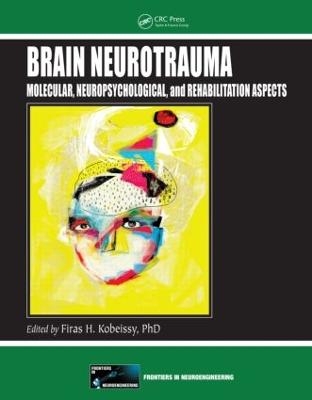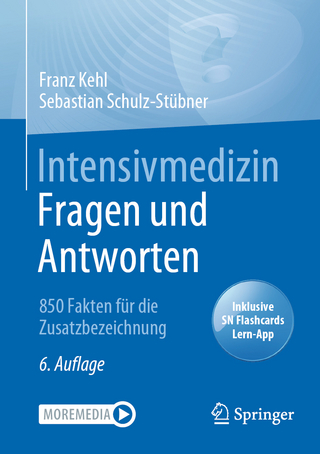
Brain Neurotrauma
Crc Press Inc (Verlag)
978-1-4665-6598-2 (ISBN)
The book includes several sections on neurotrauma mechanisms, biomarker discovery, neurocognitive/neurobehavioral deficits, and neurorehabilitation and treatment approaches. It also contains a section devoted to models of mild CNS injury, including blast and sport-related injuries.
Over the last decade, the field of neurotrauma has witnessed significant advances, especially at the molecular, cellular, and behavioral levels. This progress is largely due to the introduction of novel techniques, as well as the development of new animal models of central nervous system (CNS) injury. This book, with its diverse coherent content, gives you insight into the diverse and heterogeneous aspects of CNS pathology and/or rehabilitation needs.
Firas Hosni Kobeissy is an assistant professor in the Department of Psychiatry of the University of Florida McKnight Brain Institute and serves as the associate scientific director of the Center for Neuroproteomics and Biomarkers Research. He earned his PhD from the University of Florida and has published in the field of brain injury biomarkers, neuroproteomics, and neurosystems biology. Dr. Kobeissy’s current research overlaps the fields of neuroscience and psychiatry with a focus on drug abuse neurotoxicity and traumatic brain injury neuroproteomics. He has published more than 70 peer-reviewed papers, reviews, and book chapters as well as co-edited three books. He has also co-authored five U.S. patents. Dr. Kobeissy serves as an editorial member on several journals related to proteomics, neuroscience, and brain injury and has been a member on several study sections of brain injury and stroke. Stuart W. Hoffman is the scientific program manager of the brain injury portfolio in the rehabilitation research and development service at the U.S. Department of Veteran Affairs (VA) The portfolio is focused on promoting translational research that improves outcomes in veterans living with the chronic effects of stroke, traumatic brain injury, and its co-morbidities. He also represents VA/ORD on TBI research. In this role, he is the co-chair of the government steering committee for the VA/DoD Chronic Effects of Neurotrauma Consortium, as well as a member of several advisory boards for VA research centers, and serves on the congressionally mandated Traumatic Brain Injury Advisory Committee for the Veterans Health Administration. He received his doctoral degree in behavioral and molecular neuroscience at Rutgers University.
Experimental CNS Trauma: A General Overview of Neurotrauma Research. Combat TBI: History, Epidemiology, and Injury Modes. Neuromechanisms in Brain Injury. Development of Concepts in the Pathology of Traumatic Axonal and Traumatic Brain Injury. Pathophysiology of Mild TBI: Implications for Altered Signaling Pathways. Oxidative Stress, Brain-Edema, Blood-Brain Barrier Permeability, and Autonomic Dysfunction from Traumatic Brain Injury. The Contributing Role of Lipid Peroxidation and Protein Oxidation in the Course of CNS Injury Neurodegeneration and Neuroprotection: An Overview. IGF-1/IGF-R Signaling in Traumatic Brain Injury: Impact on Cell Survival, Neurogenesis, and Behavioral Outcome. Microglia in Experimental Brain Injury: Implications on Neuronal Injury and Circuit Remodeling. Evaluating the Effects of APOE4 after Mild Traumatic Brain Injury in Experimental Models. Cytoprotective Role of Prostaglandin D2 DP1 Receptor against Neuronal Injury Following Acute Excitotoxicity and Cerebral Ischemia. Management in CNCNS Trauma. Chronic Pain in Neurotrauma: Implications on Spinal Cord and Traumatic Brain Injury. Nonconvulsive Seizures as Secondary Insults in Experimental Traumatic Brain Injury. Characterization and Management of Headache after Mild Traumatic Brain Injury. Traumatic Brain Injury (TBI)-Induced Spasticity: Neurobiology, Treatment, and Rehabilitation. Modeling Brain Injury. Techniques and Methods of Animal Brain Surgery: Perfusion, Brain Removal, and Histological Techniques. Controlled Cortical Impact Model. A Two-Model Approach to Investigate the Mechanisms Underlying Blast-Induced Traumatic Brain Injury. Acute Pathophysiology of Blast Injury—From Biomechanics to Experiments and Computations: Implications on Head and Polytrauma. Modeling Fluid Percussion Injury: Relevance to Human Traumatic Brain Injury. Imaging and Biomarkers. CNS Trauma Biomarkers and Surrogate Endpoints Pipeline from Bench to Bedside: A Translational Perspective. The Use and Potential of pNF-H as a General Blood Biomarker of Axonal Loss: An Immediate Application for CNS Injury. Exploring Serum Biomarkers for Mild Traumatic Brain Injury. Modeling the Neurobehavioral Consequences of Blast-Induced Traumatic Brain Injury Spectrum Disorder and Identifying Related Biomarkers. Magnetic Resonance Imaging Application in the Area of Mild and Acute Traumatic Brain Injury: Implication for Diagnostic Markers. Translational Metabolomics of Head Injury: Exploring Dysfunctional Cerebral Metabolism with Ex Vivo NMR Spectroscopy-Based Metabolite Quantification. The Emerging Impact of microRNAs in Neurotrauma Pathophysiology and Therapy. Neuroproteome Dynamics in Modeled Brain Injury: A Systems Neurobiology Perspective. Gene Interaction Hierarchy Analysis Can Be an Effective Tool for Managing Big Data Related to Unilateral Traumatic Brain Injury. Autoantibodies in CNS Trauma and Neuropsychiatric Disorders: A New Generation of Biomarkers. Systems Biology Application to Decipher Mechanisms and Novel Biomarkers in CNS Trauma. Neurocognitive and Neurobehavioral Topics in Brain Injury. Neuropathology of Mild Traumatic Brain Injury: Correlation to Neurocognitive and Neurobehavioral Findings. Blast-Related Mild Traumatic Brain Injury: Neuropsychological Evaluation and Findings. Persistent Cognitive Deficits: Implications of Altered Dopamine in Traumatic Brain Injury. Neurorehabilitation and Neuroprotection. Rehabilitative Paradigms after Experimental Brain Injury: Relevance to Human Neurotrauma. Models of Posttraumatic Brain Injury Neurorehabilitation. Translational Considerations for Behavioral Impairment and Rehabilitation Strategies after Diffuse Traumatic Brain Injury. Endothelin, Cerebral Blood Flow, and Traumatic Brain Injury: Implications for a Future Therapeutic Target. Application of Novel Therapeutic Agents for CNS Injury: NAAG Peptidase Inhibitors. Neuregulin-1 and Neurovascular Protection. Potential Use of Calpain Inhibitors as Brain Injury Therapy. Nanoparticles for Neurotherapeutic Drug Delivery in Neurodegenerative Disorders: Application in Neurotrauma. Stem Cell Therapy in Brain Trauma: Implications for Repair and Regeneration of Injured Brain in Experimental TBI Models. Cortical Stimulation-Induced Structural Plasticity and Functional Recovery after Brain Damage. Cranial Nerve Noninvasive Neuromodulation: New Approach to Neurorehabilitation. Mild Brain Injury and Sport Concussion. Blast Injuries and Blast-Induced Neurotrauma: Overview of Pathophysiology and Experimental Knowledge—Models and Findings. Animal Models for Concussion: Molecular and Cognitive Assessments—Relevance to Sport and Military Concussions. The Problem of Neurodegeneration in Cumulative Sports Concussions: Emphasis on Neurofibrillary Tangle Formation. Substance Abuse and Comorbid Conditions. Evidence for Beneficial and Adverse Effects of Alcohol in Animal Models and Clinical Studies of Traumatic Brain Injury. Modeling Traumatic Brain Injury-Induced Alterations in Alcohol Use Behaviors.
| Reihe/Serie | Frontiers in Neuroengineering Series |
|---|---|
| Zusatzinfo | 51 Tables, black and white; 212 Illustrations, black and white |
| Verlagsort | Bosa Roca |
| Sprache | englisch |
| Maße | 210 x 280 mm |
| Gewicht | 2109 g |
| Themenwelt | Medizin / Pharmazie ► Allgemeines / Lexika |
| Medizinische Fachgebiete ► Chirurgie ► Neurochirurgie | |
| Medizin / Pharmazie ► Medizinische Fachgebiete ► Neurologie | |
| Medizin / Pharmazie ► Medizinische Fachgebiete ► Notfallmedizin | |
| Physiotherapie / Ergotherapie ► Rehabilitation ► Neuro-Rehabilitation | |
| Naturwissenschaften ► Biologie ► Humanbiologie | |
| Naturwissenschaften ► Biologie ► Zoologie | |
| ISBN-10 | 1-4665-6598-5 / 1466565985 |
| ISBN-13 | 978-1-4665-6598-2 / 9781466565982 |
| Zustand | Neuware |
| Informationen gemäß Produktsicherheitsverordnung (GPSR) | |
| Haben Sie eine Frage zum Produkt? |
aus dem Bereich


